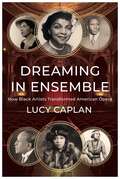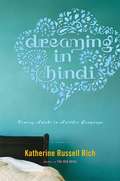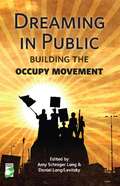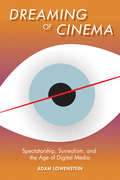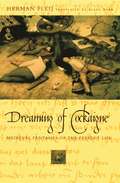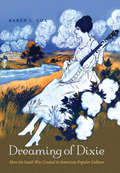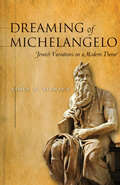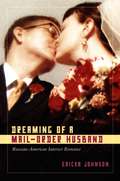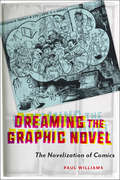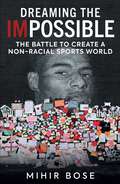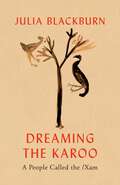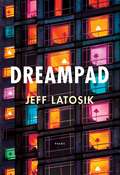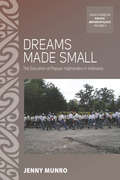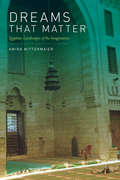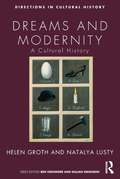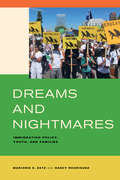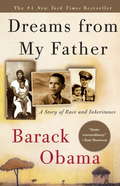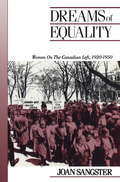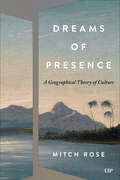- Table View
- List View
Dreaming in Ensemble: How Black Artists Transformed American Opera
by Lucy CaplanA revelatory new account of Black innovation in American opera, showing how composers, performers, and critics redefined the genre both aesthetically and politically in the early twentieth century.The inauguration of a “golden age” in Black opera is often dated to 1955, when Marian Anderson became the first Black singer to perform in a leading role at New York’s Metropolitan Opera. Yet Anderson’s debut was actually preceded by a rich Black operatic tradition that developed in the first half of the twentieth century. Lucy Caplan tells the stories of the Black composers, performers, critics, teachers, and students who created this vibrant opera culture, even as they were excluded from the genre’s most prominent institutions. Their movement, which flourished alongside the Harlem Renaissance, redefined opera as a wellspring of aesthetic innovation, sociality, and antiracist activism.Caplan argues that Black opera in the early twentieth century had decidedly countercultural ambitions. In opera’s sonic grandeur and dramatic maximalism, artists found creative resources for expressing the complexity of Black life. The protagonists of this story include composers Harry Lawrence Freeman and Shirley Graham, whose operas boldly interpreted Black diasporic history; performers Caterina Jarboro and Florence Cole-Talbert, who both starred in the racially fraught role of Aida; and critics Sylvester Russell and Nora Holt, who wrote imaginatively about the genre in the Black press. Yet Caplan also focuses on the many Black students, amateurs, opera house staff, and listeners who contributed indelibly to opera’s meanings.With the creation of new companies, choruses, and audiences, opera not only circulated in the Black public sphere but itself became a public sphere with radical potential.
Dreaming in Hindi: Coming Awake in Another Language
by Katherine Russell RichAn eye-opening and courageous memoir that explores what learning a new language can teach us about distant worlds and, ultimately, ourselves. After miraculously surviving a serious illness, Katherine Rich found herself at an impasse in her career as a magazine editor. She spontaneously accepted a freelance writing assignment to go to India, where she found herself thunderstruck by the place and the language, and before she knew it she was on her way to Udaipur, a city in the northwestern state of Rajasthan, in order to learn Hindi. Rich documents her experiences--ranging from the bizarre to the frightening to the unexpectedly exhilarating--using Hindi as the lens through which she is given a new perspective not only on India, but on the radical way the country and the language itself were changing her. Fascinated by the process, she went on to interview linguistics experts around the world, reporting back from the frontlines of the science wars on what happens in the brain when we learn a new language. She brings both of these experiences together seamlessly in Dreaming in Hindi, a remarkably unique and thoughtful account of self-discovery.
Dreaming in Public
by Daniel Lang Levitsky Amy LangSince September 2011, the Occupy movement has captured the world's imagination. The media has been flooded with accounts of demonstrations, descriptions of the encampments, interviews with Occupiers, and discussions of Occupy's merits, political and otherwise. But what do its participants have to say? Dreaming in Public gathers together dispatches, essays, blog posts, and images from within the movement aimed at influencing its development and addressing those not yet in the streets and plazas. Produced by participant journalists, political analysts, writers, polemicists, photographers, organizers, and activists, these documents capture the vibrant, contentious, illuminating, and inventive exchange of Occupy. Work from contributors such as Naomi Klein and Harsha Walia complement public declarations from the movement, images, and graphics. Some pieces explore the rites and rituals of the movement, others its aims and overall structure. Yet others take up the role differences of race and gender play in a movement that claims to represent the 99%, and the complicated business of maintaining urban encampments. Many consider the challenge participatory democracy poses to conventional ideas of what politics is or should be. The materials in this collection attest not only to the extraordinary political energy that has already come out of Occupy, but to the implications of the movement for the future. Amy Schrager Lang is professor of English and humanities at Syracuse University and author of a number of books. Daniel Lang/Levitsky is an artist, theater producer, writer, and founding member of the Direct Action Network and Jews Against the Occupation.
Dreaming of Cinema
by Adam LowensteinAdam Lowenstein argues that Surrealism's encounter with film can help redefine the meaning of cinematic spectatorship in an era of popular digital entertainment.
Dreaming of Cinema: Spectatorship, Surrealism, and the Age of Digital Media (Film and Culture Series)
by Adam LowensteinVideo games, YouTube channels, Blu-ray discs, and other forms of "new" media have made theatrical cinema seem "old." A sense of "cinema lost" has accompanied the ascent of digital media, and many worry film's capacity to record the real is fundamentally changing. Yet the Surrealist movement never treated cinema as a realist medium and understood our perceptions of the real itself to be a mirage. Returning to their interpretation of film's aesthetics and function, this book reads the writing, films, and art of Luis Buñuel, Salvador Dalí, Man Ray, André Breton, André Bazin, Roland Barthes, Georges Bataille, Roger Caillois, and Joseph Cornell and recognizes their significance for the films of David Cronenberg, Nakata Hideo, and Atom Egoyan; the American remake of the Japanese Ring (1998); and a YouTube channel devoted to Rock Hudson. Offering a positive alternative to cinema's perceived crisis of realism, this innovative study enriches the meaning of cinematic spectatorship in the twenty-first century.
Dreaming of Cockaigne: Medieval Fantasies of the Perfect Life
by Herman PleijImagine a dreamland where roasted pigs wander about with knives in their backs to make carving easy, where grilled geese fly directly into one's mouth, where cooked fish jump out of the water and land at one's feet. The weather is always mild, the wine flows freely, sex is readily available, and all people enjoy eternal youth.Such is Cockaigne. Portrayed in legend, oral history, and art, this imaginary land became the most pervasive collective dream of medieval times-an earthly paradise that served to counter the suffering and frustration of daily existence and to allay anxieties about an increasingly elusive heavenly paradise.Illustrated with extraordinary artwork from the Middle Ages, Herman Pleij's Dreaming of Cockaigne is a spirited account of this lost paradise and the world that brought it to life. Pleij takes three important texts as his starting points for an inspired of the panorama of ideas, dreams, popular religion, and literary and artistic creation present in the late Middle Ages. What emerges is a well-defined picture of the era, furnished with a wealth of detail from all of Europe, as well as Asia and America.Pleij draws upon his thorough knowledge of medieval European literature, art, history, and folklore to describe the fantasies that fed the tales of Cockaigne and their connections to the central obsessions of medieval life.
Dreaming of Dixie
by Karen L. CoxFrom the late nineteenth century through World War II, popular culture portrayed the American South as a region ensconced in its antebellum past, draped in moonlight and magnolias, and represented by such southern icons as the mammy, the belle, the chivalrous planter, white-columned mansions, and even bolls of cotton. InDreaming of Dixie, Karen Cox shows that the chief purveyors of this constructed nostalgia for the Old South were outsiders of the region, especially advertising agencies, musicians, publishers, radio personalities, writers, and filmmakers playing to consumers' anxiety about modernity by marketing the South as a region still dedicated to America's pastoral traditions. Cox examines how southerners themselves embraced the imaginary romance of the region's past, particularly in the tourist trade as southern states and cities sought to capitalize on popular perceptions by showcasing their Old South heritage. Only when television emerged as the most influential medium of popular culture did views of the South begin to change, as news coverage of the civil rights movement brought images of violence, protest, and conflict in the South into people's living rooms. Until then, Cox argues, most Americans remained content with their romantic vision of Dixie.
Dreaming of Michelangelo: Jewish Variations on a Modern Theme
by Asher D. BiemannDreaming of Michelangelois the first book-length study to explore the intellectual and cultural affinities between modern Judaism and the life and work of Michelangelo Buonarroti. It argues that Jewish intellectuals found themselves in the image of Michelangelo as an "unrequited lover" whose work expressed loneliness and a longing for humanity's response. The modern Jewish imagination thus became consciously idolatrous. Writers brought to life-literally-Michelangelo's sculptures, seeing in them their own worldly and emotional struggles. The Moses statue in particular became an archetype of Jewish liberation politics as well as a central focus of Jewish aesthetics. And such affinities extended beyond sculpture: Jewish visitors to the Sistine Chapel reinterpreted the ceiling as a manifesto of prophetic socialism, devoid of its Christian elements. According to Biemann, the phenomenon of Jewish self-recognition in Michelangelo's work offered an alternative to the failed promises of the German enlightenment. Through this unexpected discovery, he rethinks German Jewish history and its connections to Italy, the Mediterranean, and the art of the Renaissance.
Dreaming of a Mail-Order Husband: Russian-American Internet Romance
by Ericka JohnsonIn the American media, Russian mail-order brides are often portrayed either as docile victims or as gold diggers in search of money and green cards. Rarely are they allowed to speak for themselves. Until now. In Dreaming of a Mail-Order Husband, six Russian women who are in search of or have already found U. S. husbands via listings on the Internet tell their stories. Ericka Johnson, an American researcher of gender and technology, interviewed these women and others. The women, in their twenties and thirties, describe how they placed listings on the Internet and what they think about their contacts with Western men. They discuss their expectations about marriage in the United States and their reasons for wishing to emigrate. Their differing backgrounds, economic situations, and educational levels belie homogeneous characterizations of Russian mail-order brides. Each chapter presents one woman's story and then links it to a discussion of gender roles, the mail-order bride industry, and the severe economic and social constraints of life in Russia. The transitional economy has often left people, after a month's work, either unpaid or paid unexpectedly with a supply of sunflower oil or toilet paper. Women over twenty-three are considered virtually unmarriageable in Russian society. Russia has a large population of women who are single, divorced, or widowed, who would like to be married yet feel that they have no chance finding a Russian husband. Grim realities such as these motivate women to seek better lives abroad. For many of those seeking a mail-order husband, children or parents play significant roles in the search for better lives, and they play a role in Johnson's account as well. In addition to her research in the former Soviet Union, Johnson conducted interviews in the United States, and she shares the insights--about dating, marriage, and cross-cultural communication--of a Russian-American married couple who met via the Internet.
Dreaming the Graphic Novel: The Novelization of Comics
by Paul WilliamsThe term “graphic novel” was first coined in 1964, but it wouldn’t be broadly used until the 1980s, when graphic novels such as Watchmen and Maus achieved commercial success and critical acclaim. What happened in the intervening years, after the graphic novel was conceptualized yet before it was widely recognized? Dreaming the Graphic Novel examines how notions of the graphic novel began to coalesce in the 1970s, a time of great change for American comics, with declining sales of mainstream periodicals, the arrival of specialty comics stores, and (at least initially) a thriving underground comix scene. Surveying the eclectic array of long comics narratives that emerged from this fertile period, Paul Williams investigates many texts that have fallen out of graphic novel history. As he demonstrates, the question of what makes a text a ‘graphic novel’ was the subject of fierce debate among fans, creators, and publishers, inspiring arguments about the literariness of comics that are still taking place among scholars today. Unearthing a treasure trove of fanzines, adverts, and unpublished letters, Dreaming the Graphic Novel gives readers an exciting inside look at a pivotal moment in the art form’s development.
Dreaming the Impossible: The Battle to Create a Non-Racial Sports World
by Mihir BoseShortlisted for the 2023 Sports Book Awards for Best Sports Writing of the Year The British, who are rightly proud of their sporting traditions, are now having to come to terms with the dark, unacknowledged, past of racism in sport – until now the truth that dare not speak its name. Conscious and unconscious racism have for decades blighted the lives of talented black and Asian sportsmen and women, preventing them from fulfilling their potential. In Formula One, despite Lewis Hamilton’s stellar achievements, barely one per cent of the 40,000 people employed in the sport are of ethnic minority heritage. In football, Britain’s premier sport, the number of non-white managers in the professional game remains pitifully small. And in cricket, Azeem Rafiq’s testimony to the Commons select committee has exposed the scandal of prejudice faced by Asian cricketers in the game. Veteran author and journalist Mihir Bose examines the way racism has affected black and Asian sportsmen and women and how attitudes have evolved over the past fifty years. He looks in depth at the controversies that have beset sport at all levels: from grassroots to international competitions and how the ‘Black Lives Matter’ movement has had a seismic impact throughout sport, with black sports personalities leading the fight against racism. However, this has also led to a worrying white fatigue. Talking to people from playing field to boardroom and the media world, he illustrates the complexities and striking contrasts in attitudes towards race. We hear the voices of players, coaches and administrators as Mihir Bose explores the question of how the dream of a truly non-racial sports world can become a reality. The Marcus Rashford mural featured on the cover was commissioned by the Withington Walls community art project, created by artist AskeP19 (@akse_p19) and based on photography by Danny Cheetham (@dannycheetham). To find out more about the Withington Walls project, you can follow them at @Withingtonwalls on both Twitter and Instagram, or visit their website: www.withingtonwalls.co.uk
Dreaming the Karoo: A People Called the /Xam
by Julia BlackburnA spellbinding new book by the much-acclaimed writer, a journey to South Africa in search of the lost people called the /Xam - a haunting book about the brutality of colonial frontiers and the fate of those they dispossess.In spring 2020, Julia Blackburn travelled to the Karoo region of South Africa to see for herself the ancestral lands that had once belonged to an indigenous group called the /Xam.Throughout the nineteenth century the /Xam were persecuted and denied the right to live in their own territories. In the 1870s, facing cultural extinction, several /Xam individuals agreed to teach their intricate language to a German philologist and his indomitable English sister-in-law. The result was the Bleek-Lloyd Archive: 60,000 notebook pages in which their dreams, memories and beliefs, alongside the traumas of their more recent history, were meticulously recorded word for word. It is an extraordinary document which gives voice to a way of living in the world which we have all but lost. 'All things were once people', the /Xam said.Blackburn's journey to the Karoo was cut short by the outbreak of the global pandemic, but she had gathered enough from reading the archive, seeing the /Xam lands and from talking to anyone and everyone she met along the way, to be able to write this haunting and powerful book, while living her own precarious lockdown life. Dreaming the Karoo is a spellbinding new masterpiece by one of our greatest and most original non-fiction writers.'An astounding, disarming book, full of grief and beauty' Olivia Laing'Blackburn's wise, wonderfully idiosyncratic books are poetic, informed by a...genius for serendipity' Lucy Hughes-Hallett, New Statesman
Dreampad
by Jeff LatosikA hopeful, timely new collection of poems that take up our ever-evolving relationship with technology.Starting from an urge to reconcile the human need for stability with what's happening in a constantly fluid "now," Dreampad, Trillium Book Award for Poetry winner poet Jeff Latosik's startling new collection, ponders whether an ideal for living is viable when we're not sure we can say yes or no to anything in a world that's growing increasingly ephemeral and entangled with the virtual.These poems, however, are a salvo--or "protest" in the most useful sense of that word--a reminder we might already own a verbal architecture to express the difficulty of being alive in a world that can, could, and might still even be humane, loving, habitable.
Dreams (Amazing You #23)
by Theresa CheungEver woken up from a dream and wondered what it was trying to tell you? Your dreams reveal your innermost thoughts, feelings, hopes and fears. They tell the story of the real YOU. Explore what different types of dreams mean and how you can use them for guidance and inspiration. Learn how to turn your dreams into creative and productive experiences to help you deal with real life: boys, friends, health, family and work. Dreams shows you how you can change your everyday life by discovering just how incredible you are. It is part of our stunning new Mind Body Spirit series for teenage girls - Amazing You.
Dreams Achieved and Denied: Mexican Intergenerational Mobility (American Sociological Association's Rose Series)
by Robert Courtney SmithU.S.-born Mexicans in New York City have achieved perhaps the biggest single generation jump in mobility in American immigration history. In 2020, 42-percent of second-generation U.S.-born Mexican men and 49-percent of U.S.-born Mexican women in New York City had graduated from college – versus a 13-14-percent second-generation college graduation rate for most places for most studies done in recent decades. How did U.S.-born Mexicans in New York City achieve such remarkable mobility? In Dreams Achieved and Denied, sociologist Robert Courtney Smith examines the laws, policies, and individual and family practices that promoted – and inhibited – their social mobility. For over twenty years, Smith followed the lives and mobility of nearly one hundred children of Mexican immigrants in New York City. Smith’s longitudinal, ethnographic data enabled him to intimately describe how specific mechanisms blocked or promoted mobility for years as his participants moved from adolescence through early adulthood and into established adulthood. Smith documents how having or gaining legal status made certain New York City or New York State policies and practices more efficacious in supporting individual and family efforts and strategies for mobility. Such immigrant-inclusive and mobility-promoting measures include enabling undocumented people to attend public colleges at in-state tuition rates, and later to get driver’s licenses, offering healthcare to all in New York City, and the City’s subway and school choice systems, which enabled students to attend better schools or take opportunities outside their neighborhoods. Smith finds that keeping the immigrant bargain – whereby children of immigrants redeem their parents’ sacrifice by doing well in school, helping their parents and siblings, and becoming “good” people (in their parents’ words) – helped them towards better adult outcomes and lives. Having mentors, picking academically stronger schools and friends, and using second chance mechanisms also promoted more adult mobility. However, lacking legal status blocked mobility, by preventing them from benefiting from these same mobility-promoting city and state policies, from mentors, or from working hard and keeping the immigrant bargain. Dreams Achieved and Denied deeply analyzes the historic upward mobility of U.S.-born Mexicans in New York City. Itcounters the dominant story research and public discourse tell about Mexican mobility in the U.S. and shows how thoughtful public policy can improve the lives of young immigrants and families.
Dreams Made Small: The Education of Papuan Highlanders in Indonesia (ASAO Studies in Pacific Anthropology #9)
by Jenny MunroFor the last five decades, the Dani of the central highlands of West Papua, along with other Papuans, have struggled with the oppressive conditions of Indonesian rule. Formal education holds the promise of escape from stigmatization and violence. Dreams Made Small offers an in-depth, ethnographic look at journeys of education among young Dani men and women, asking us to think differently about education as a trajectory for transformation and belonging, and ultimately revealing how dreams of equality are shaped and reshaped in the face of multiple constraints.
Dreams That Matter: Egyptian Landscapes of the Imagination
by Amira MittermaierDreams that Matter explores the social and material life of dreams in contemporary Cairo. Amira Mittermaier guides the reader through landscapes of the imagination that feature Muslim dream interpreters who draw on Freud, reformists who dismiss all forms of divination as superstition, a Sufi devotional group that keeps a diary of dreams related to its shaykh, and ordinary believers who speak of moving encounters with the Prophet Muhammad. In close dialogue with her Egyptian interlocutors, Islamic textual traditions, and Western theorists, Mittermaier teases out the dream's ethical, political, and religious implications. Her book is a provocative examination of how present-day Muslims encounter and engage the Divine that offers a new perspective on the Islamic Revival. Dreams That Matter opens up new spaces for an anthropology of the imagination, inviting us to rethink both the imagined and the real.
Dreams and Modernity: A Cultural History (Directions in Cultural History)
by Natalya Lusty Helen GrothDreams and Modernity: A Cultural History explores the dream as a distinctively modern object of inquiry and as a fundamental aspect of identity and culture in the nineteenth and early twentieth century. While dreams have been a sustained object of fascination from the ancient world to the present, what sets this period apart is the unprecedented interest in dream writing and interpretation in the psychological sciences, and the migration of these ideas into a wide range of cultural disciplines and practices. Authors Helen Groth and Natalya Lusty examine how the intensification and cross-fertilization of ideas about dreams in this period became a catalyst for new kinds of networks of knowledge across aesthetic, psychological, philosophical and vernacular domains. In uncovering a complex and diverse archive, Dreams and Modernity reveals how the explosion of interest in dreams informed the psychic, imaginative and intimate life of the modern subject. Individual chapters in the book explore popular traditions of dream interpretation in the 19th century; the archival impetus of dream research in this period, including the Society for Psychical Research and the Mass Observation movement; and the reception and extension of Freud’s dream book in Britain in the early decades of the twentieth century. This engaging interdisciplinary book will appeal to both scholars and upper level students of cultural studies, cultural history, Victorian studies, literary studies, gender studies and modernist studies.
Dreams and Nightmares
by Marjorie S. Zatz Nancy RodriguezDreams and Nightmares takes a critical look at the challenges and dilemmas of immigration policy and practice in the absence of comprehensive immigration reform. The experiences of children and youth provide a prism through which the interwoven dynamics and consequences of immigration policy become apparent. Using a unique sociolegal perspective, authors Zatz and Rodriguez examine the mechanisms by which immigration policies and practices mitigate or exacerbate harm to vulnerable youth. They pay particular attention to prosecutorial discretion, assessing its potential and limitations for resolving issues involving parental detention and deportation, unaccompanied minors, and Dreamers who came to the United States as young children. The book demonstrates how these policies and practices offer a means of prioritizing immigration enforcement in ways that alleviate harm to children, and why they remain controversial and vulnerable to political challenges.
Dreams from My Father: A Story of Race and Inheritance (Canons #54)
by Barack ObamaIn this lyrical, unsentimental, and compelling memoir, the son of a black African father and a white American mother searches for a workable meaning to his life as a black American. It begins in New York, where Barack Obama learns that his father--a figure he knows more as a myth than as a man--has been killed in a car accident. This sudden death inspires an emotional odyssey--first to a small town in Kansas, from which he retraces the migration of his mother's family to Hawaii, and then to Kenya, where he meets the African side of his family, confronts the bitter truth of his father's life, and at last reconciles his divided inheritance. Pictured in lefthand photograph on cover: Habiba Akumu Hussein and Barack Obama, Sr. (President Obama's paternal grandmother and his father as a young boy). Pictured in righthand photograph on cover: Stanley Dunham and Ann Dunham (President Obama's maternal grandfather and his mother as a young girl). From the Trade Paperback edition.
Dreams in Chinese Fiction: Spiritism, Aestheticism, and Nationalism (Routledge Focus on Literature)
by Johannes D. KaminskiThis book considers the contemporary political formula of the “Chinese Dream” in the light of the treatment of dreams in Chinese literary history since antiquity. Sinic literary and philosophical texts document an extensive spectrum of dream possibilities: starting with Zhuangzi’s eminent butterfly dream, an early example of the inversion of the dreamer’s reality, through to confusing visions of the spiritual realm. In classical dramas, novels, and ghost stories, dreams see the earthly realm enter into conflict with higher realms of existence. They indulge the dreamer’s quest for sensual pleasures, but then spiritual beings relentlessly harvest the dreamers’ life energy. Dreams promise spiritual enlightenment – only to abandon the dreamer in a state of utter confusion. In the early twentieth century, traditional dream knowledge is abandoned in favour or Freudian episodes of sexual repression. In this context, the collective national dream emerges as an unexpected vehicle of the pained individual’s hope for national rejuvenation.
Dreams of Equality
by Joan SangsterCanadian women on the political left in the first half of the twentieth century fought with varying degrees of commitment for women's rights. Women's dreams of equality were in part a vision of economic and class equality, though they also represented profound desires for equality with men - both within their own parties and in the larger society. In both the Communist Party of Canada and the Co-operative Commonwealth Federation, a male-dominated leadership seldom embraced women's causes wholeheartedly or as a doctrinal priority. So-called women's issues, whether birth control, consumer issues, or equal pay, usually took second place to an emphasis on the general needs of workers or farmers. Nonetheless, many women continued to promote their feminist causes through the socialist movement, in the hope that, eventually, the socialist New Jerusalem would see their dreams of equality fulfilled.In Dreams of Equality, Joan Sangster chronicles in fascinating detail the first tentative stages of a politically aware women's movement in Canada, from the time of women's suffrage to the 1950's when the CPC went into decline and the CCF began to experience the changes that would evolve into the New Democratic Party a decade later.
Dreams of Flight: The Lives of Chinese Women Students in the West
by Fran MartinIn Dreams of Flight, Fran Martin explores how young Chinese women negotiate competing pressures on their identity while studying abroad. On one hand, unmarried middle-class women in the single-child generations are encouraged to develop themselves as professional human capital through international education, molding themselves into independent, cosmopolitan, career-oriented individuals. On the other, strong neotraditionalist state, social, and familial pressures of the post-Mao era push them back toward marriage and family by age thirty. Martin examines these women’s motivations for studying in Australia and traces their embodied and emotional experiences of urban life, social media worlds, work in low-skilled and professional jobs, romantic relationships, religion, Chinese patriotism, and changed self-understanding after study abroad. Martin illustrates how emerging forms of gender, class, and mobility fundamentally transform the basis of identity for a whole generation of Chinese women.
Dreams of Presence: A Geographical Theory of Culture
by Mitch RoseThroughout the twentieth century, the question of culture was a central pillar of social scientific thought. Today, however, the concept has disappeared from the academic landscape. Despite pressing political debates about culture wars, identity politics, cultural appropriation, and nativism, the concept of culture is no longer seen as a credible explanatory tool. Dreams of Presence provides a novel theoretical approach to the question of culture and will be of use to geographers, anthropologists, sociologists, and social theorists grappling to understand why culture continues to be a dominant political force in our contemporary world. Drawing on Heidegger, Levinas, Derrida, and Žižek, Mitch Rose provides an existential, rather than sociological, account of culture, conceptualizing it as a refuge where subjects endeavour to establish ownership over a life that perpetually eludes them. The book argues that culture is a claim; not something subjects ever have but something they desire; not something properly present but a dream of presence: an imagination of identity we cultivate, care for, and materially build in order to assure ourselves that we are sovereign, self-standing beings.
Dreams of a Lifetime: How Who We Are Shapes How We Imagine Our Future
by Janet M. Ruane Karen A. CeruloHow social status shapes our dreams of the future and inhibits the lives we envision for ourselvesMost of us understand that a person’s place in society can close doors to opportunity, but anything is possible when we dream about what might be, or so we think. Dreams of a Lifetime reveals that what and how we dream—and whether we believe our dreams can actually come true—are tied to our social class, gender, race, age, and life events.Karen Cerulo and Janet Ruane argue that our social location shapes the seemingly private and unique life of our minds. We are all free to dream about possibilities, but not all dreamers are equal. Cerulo and Ruane show how our social position ingrains itself on our mind’s eye, quietly influencing the nature of our dreams, whether we embrace dreaming or dream at all, and whether we believe that our dreams, from the attainable to the improbable, can become realities. They explore how inequalities stemming from social disadvantages pattern our dreams for ourselves, and how sociocultural disparities in how we dream exacerbate social inequalities and limit the life paths we believe are open to us.Drawing on a wealth of original interviews with people from diverse social backgrounds, Dreams of a Lifetime demonstrates how the study of our dreams can provide new avenues for understanding and combatting inequality—including inequalities that precede action or outcome.
